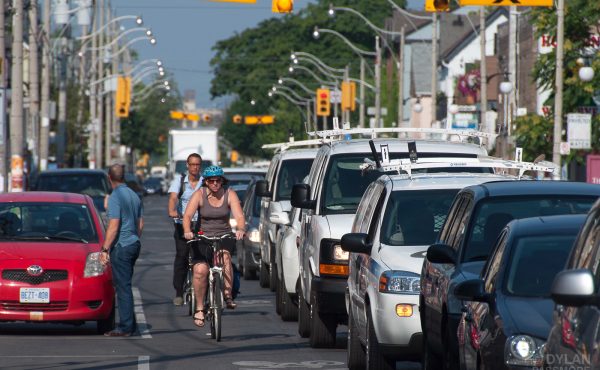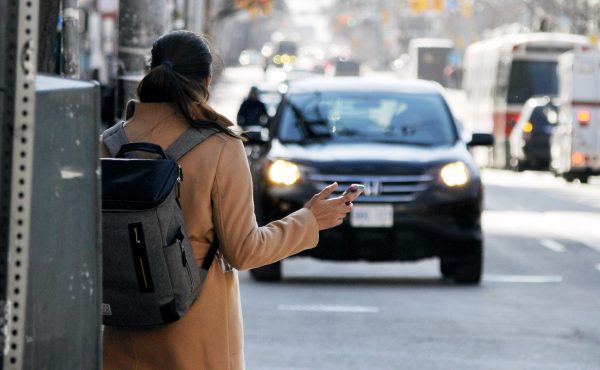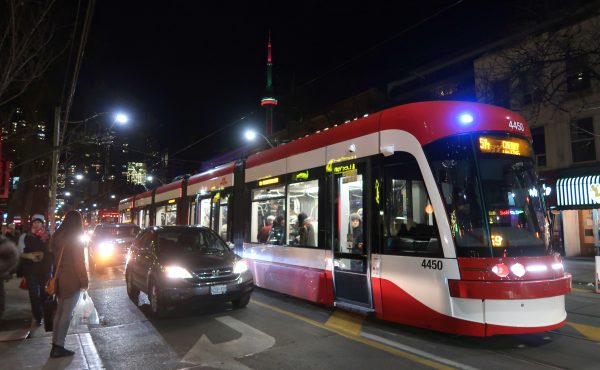
The following is a reprint of my recent Psychogeography column in Eye Weekly. Photo by Lone Primate.
In an election year very strange and illogical things happen. The dead can even come back to life. That happened a few weeks ago when mayoral candidate Rocco Rossi raised the imaginary War Against the Car from its tomb like a legislative Lazarus. The issue he used was the Jarvis bike lanes, something that was put to rest last spring after a contentious (and mostly ridiculous) battle. Raising this “wedge issue” was an early shot in a long campaign and signaled the direction he may go: divide and conquer.
It’s strange that Rossi chose to use the Jarvis lanes to stir up potential motorist votes (that is, votes largely outside of the old City of Toronto) when he is the former CEO of the Heart and Stroke Foundation, the organization whose annual signature event, the “Ride For Heart,” closes the Gardiner and DVP to all traffic but bicycles. Every year, on cue, this event draws the red-hot ire of motorists who complain of being put out and done wrong. Perhaps that’s why he knew who would react, on cue, to his anti-Jarvis stand.
Yet it would be silly for a reasonable opponent to use Ride for Heart against Rossi; it’s a good event for a good cause. But when you engage in the wedge — it is, after all, a violently shaped metaphor, one that can poke a lot of people in the eye — you risk this kind of response. Fire begets fire. Without trying to be particularly naive, it’s also politically risky in this city: wedge politicking is downright un-Torontonian. To try and divide a city that not only celebrates its differences but also enshrines them in its very soul — “Diversity our Strength” and all that — seems like an explicit rejection of what the city you want to run is all about.
The reason the Jarvis bike lanes, and the inconsequential two extra minutes of rush-hour driving time they’ll add, can still get this kind of political and media traction and whip all sides into a frenzy is because Toronto is in the weird in-between space of being almost a full-on alpha city, embracing all its big-cityness, and just another second-tier city in the eastern part of North America. In the big alpha cities like New York, London, Paris or Tokyo, nobody who drives expects to do it easily. Slow speeds, congestion, impossible parking, intense regulation and expensive fees are all just part of driving. When Mayor Bloomberg put bike lanes all over New York City, including all the way down Broadway, people grumbled, but there was no revolution.
In the second-tier cities, driving conditions are a non-issue. People can easily get around their cities, park near where they want to go (often for free) and still feel at least a bit of the romance of car driving (think American Graffiti or just about any car commercial that evokes an emotional response). Cars are just part of life and are safe as houses. Nobody would ever (want to) mess with that relationship (because there would be big trouble).
Yet that’s what happening in Toronto, and it’s why this wedge can find a slot. It isn’t a specific person or official or regime forcing the change in the way people live, it’s simply time and history. For a few decades Toronto hasn’t been a pleasure to drive in, and lots of other Canadians live in fear (fear, I tell you) of the “drive across the top” along the 401 when passing through the city to get to points east and west. As the easy-automobile age shrinks like the manufacturing economy that built it up, it’s scary if you’re a driver. All that they know is suddenly wrong and under attack. That isn’t their fault. It’s scarier, too, we’re in that middle zone of cityness: though it can be hard to drive here, the city’s transit and cycling infrastructures haven’t caught up to make not-driving a completely viable option for everybody.
The worst thing to do right now — and the thing that gives a wedge issue like Jarvis traction — is to gloat. Just like it would be good for drivers to get on a bike and see what it’s like to ride in traffic (especially the ones whose rear quarter-panels I’m always having to kick when they squeeze me into the curb after passing), everybody who doesn’t drive, should — at least a few times, and in different conditions like downtown but especially in the suburbs.
When driving, you quickly realize that a lot of the dumb things drivers do to kill you have more to do with the dynamics of the situation (big steel vs. little steel). Cyclists (and pedestrians) are small and they can sneak into places the driver didn’t expect them to be (like passing a car on the right hand side that is about to turn right itself — that’s a really dumb thing to do). Quickly, the new driver would realize that all drivers aren’t bad: the situation is.
Out in the suburbs the new drivers would learn that driving is about as awful a drag as you can imagine. No matter how wide the street, during a lot of the day much of the grid will be erratically slow. If you need to be in three or four different points in the inner suburbs over the course of a few hours — something the transit system doesn’t do particularly well either — you cede control over your life and time to traffic. You’ll swear as you’ve never sworn before. Heretofore dormant road rage will surface. Driving “out there” is nasty and brutish, and the Jarvis dynamic is suddenly clear: people are trying to make this even worse for me.
The way to de-escalate this situation is to extend Toronto’s idea of diversity from skin colour and religion to transportation choice. The cyclists don’t need bike lanes but rather “we” need to figure out how to make different kinds of transportation work together in the same place, all over the city. Actually making things happen is the hard part, but a shift in thinking from us and them to “we” is a start. Like it or not, the amalgamated city is here to stay and like the kids in the Brady Bunch (fathered by Mike Harris) we need to figure out how to live with each other so when a wedge is thrown at is, we duck and it disappears.




14 comments
Well written Shawn… you could however have just said that Rocco Rossi is a “blowhard” hypocrite. I cannot wait for your next poison dart.
@Don Corleone Did you skim the part about not fanning the flames?
The original plan for Jarvis was supposed to be widened sidewalks and better pedestrianization, but the bicycle lobby demanded lanes. It was supposed to be about making it more like Queen and less like Richmond. Since we have bike lanes on Sherbourne, why can’t the debate be about the original plan? While one day I hope we are there, we’re not yet at critical mass to have bike lanes on every major street. If we paint lanes and they remain empty, we’re playing into the hands of critics.
Hey Chris, have you ridden on Sherbourne? That asphalt is a mess, and the street is full of jaywalkers in various states of mind. It’s also a street built to keep drivers slow enough that it does not need the lanes it has; Jarvis is fast enough to be too dangerous for cyclists the way it is, but too full of stoplights to justify keeping it built as an expressway. Jarvis’ sidewalks are already huge, and won’t get more foot traffic than they have, because the east side of downtown is always going to be too rough for latte drinkers.
The Jarvis plan may or may not be a good plan… but nobody (I repeat NOBODY) really believes it will add just 2 inconsequential minutes to commute times. I don’t support Rossi and I’d hate for him (or Smitherman for that matter) to become mayor. But the success he seems to have had in building his profile has much to do with the disconnect between what the City’s planning types are saying and what many people are actually experiencing.
@Christopher
We can’t have lots of cyclists without safe bike lanes. We can’t have safe bike lanes without lots of cyclists. We can’t have lots of cyclists without safe bike lanes. We can’t…
*bangs head on desk*
Hardcore transit advocates don’t like the right, I get that and that is fine. But we cannot assume that only the left can manage it. If we do then there is no point of even having elections.
Wow! That metaphor is SO perfect!
Toronto & North York = Greg & Marcia
Etobicoke and Scarborough = Peter & Jan
York and East York = Bobby & Cindy
@jamesmallon Yes I have ridden Sherbourne, and it being chewed up has nothing to do with bike lane policy. It has to do with road maintenance and the fact that third party utility crews don’t have to repair their digging up city streets/sidewalks to the same quality as they were before. My point is that the original beautification plans for Jarvis, which involved a median and streetscape enhancements, are being thrown out over bike lanes when there is a bike lane one block east.
@Patrick We can, but the only places that bikes are used extensively that I’ve seen are on College and incidentally on roads that don’t have bike lanes (Dundas and Queen). I can’t speak for Bloor as I’m rarely that far north, but it seems to me that lanes would work there too. What I mean by that is that Dundas and Queen should have bike lanes, but not Jarvis (in fact I think that between University and Bathurst, Queen should remove a whole car lane in each direction and split the room between sidewalks and bike lanes…maybe even leaving the remaining lane as streetcar only. A pipe dream.). Most casual and commuter bicyclists go east west because of the hill effect going North. Rocco’s policy of no bike lanes on arterials is bad policy, especially since there are zero other continuous streets downtown where cycle rates are highest. I wish he’d show a map or something of what he would do instead as it makes little sense. I am a proponent of bike lanes, but if I’m defending empty lanes to my friends, coworkers, or whomever are the other centrist voters they’re going to vote for Smitherman or Rossi on those very wedge issues.
@samg Even if it added 2 hours Jarvis is inconsequential in the grand scheme of things unless you’re from Rosedale. I prefer making Jarvis a nicer place to be, not go through. I think it should be encouraged to become a place where people stop.
Also, we’ve had 8 years of what’s supposed to be a very friendly to bikes council. Their current record is very poor on expanding the network. At best they’ve managed to straggle in an ad-hoc expansion.
@christopher…
Again, I wasn’t saying anything about whether the Jarvis plan or the delay in commute times (whether 2 minutes or 2 hours) was a good or bad thing. I was merely pointing out that Rossi is having the success he is having because many people’s experience doesn’t jive with the delays planning types project for these sorts of changes. What also doesn’t jive in many people’s experience is the claim that only those commuting from Rosedale will be inconvenienced. I’m not from Rosedale, I don’t drive on Jarvis (barely drive at all) and I don’t like what Rossi is saying about any number of things. But he’s getting the traction he is because a lot of City Hall types have made claims that many people don’t find credible.
Great article, Shawn.
So far as I understand, the altering of the plan for Jarvis had to do with environmental assessments. The original plan was to widen the sidewalks, and now it’s to keep the road width the same. The original plan requires a provincial EA and the current plan only a lesser municipal EA. In other words, it’s easier for the city to, literally, change the painted lines than move the curbs. I don’t really see it as the “bicycle lobby hijacking” the plans for Jarvis. Rather, it seems the city compromised to an “anything is better than nothing” position.
Also, I think samg has a good point. The feelings and opinions of the majority of the voting public don’t seem to agree with contemporary urban planning. Fortunately, many North American cities are using these ‘new’ ideas for policy and master plans. Hopefully this will provide other cities, including Toronto, with examples and lessons.
You have a wedge issue when two parts of your opponent’s coalition (or potential coalition) will die on opposite sides of the same hill. The gun registry, for example, split the conservative rural vote from the worried urban middle class, which explains why the Conservatives hate it so much and the Liberals love it. I don’t see this in the case of bicycle lanes: which candidate has a potential block of support that simply won’t stand for bike lanes?
I think it makes more sense to describe traffic issues in general and bike lanes in particular as hot button issues, not as wedge issues.
@Christopher, in the absence of Rossi producing his alternative Bike Plan map, with a comprehensive grid of bike lanes that *never* touch arterial roads, I went ahead and imagined he had: http://www.ibiketo.ca/blog/2010/03/06/bike-lanes-imagined-rocco-rossi
My rules in making it were: the bike lane had to be as close as possible to the original bike lane (for instance, the Harbord bike lane); it could go “contra” the car traffic flow b/c contra bike lanes could be put in; and the start/end points should be about the same.
In each case the distances traveled were up to 3 times longer! Yet more evidence Rossi is talking out of his ass.
Screw Jarvis. The cyclist union has done itself WAY more harm than good by getting involved in Jarvis.
If they did it on an important bike street, like Bloor, it would be worth all the blood spilling.
As for Rocco, he knows the no-arterial rhetoric makes no sense, he’s just hoping his suburban base doesn’t notice/care.
Well said, Lukev